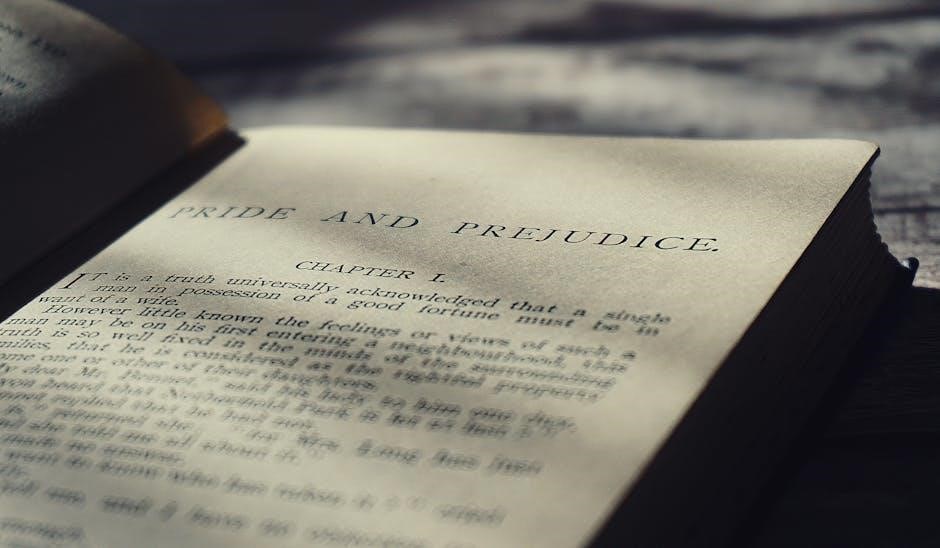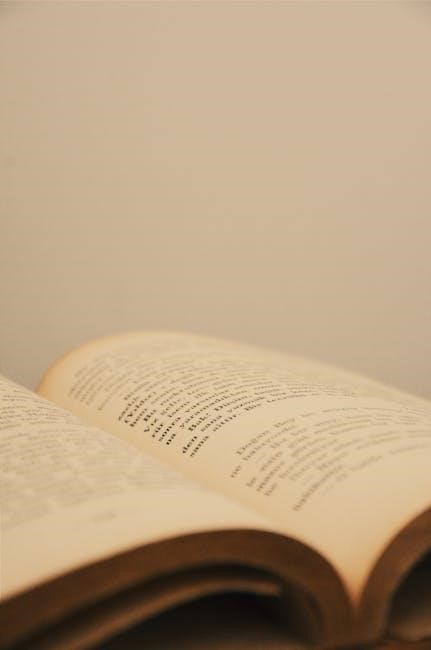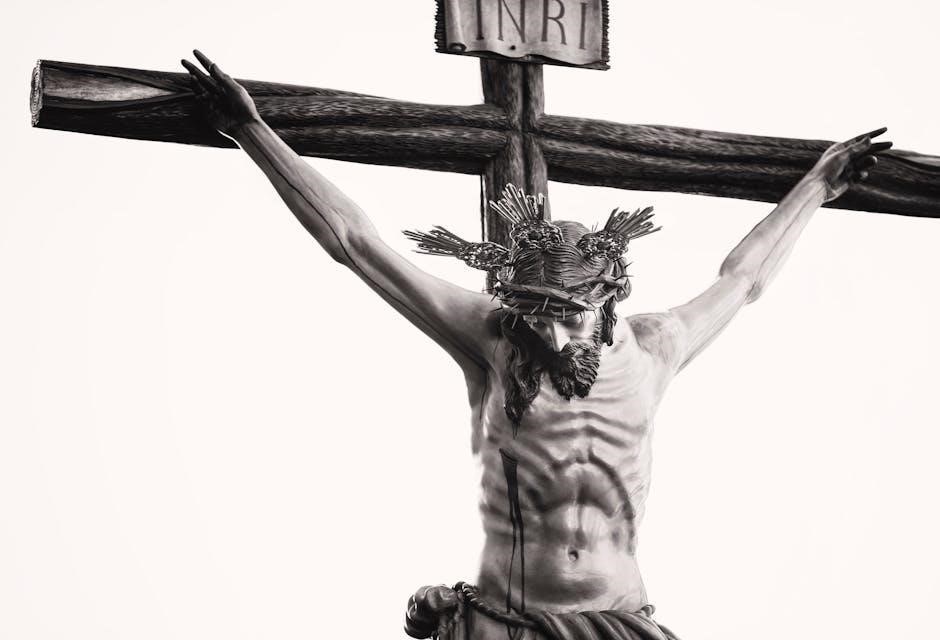
Title and Author
The novel, titled Lord of the Flies, was authored by the renowned British writer William Golding. It was first published in 1954 and remains a classic in modern literature. The story explores themes of human nature, civilization, and savagery through the experiences of boys stranded on an island. The book is widely studied and is available in various formats, including PDF, making it accessible for readers worldwide.
Lord of the Flies, written by William Golding, is a thought-provoking novel published in 1954. The story revolves around a group of British boys stranded on a remote island after a plane crash. With no adult supervision, the boys attempt to govern themselves, leading to a descent into chaos and savagery. The novel explores themes of human nature, civilization, and morality, raising questions about inherent evil and societal influences. Available in PDF format, the novel remains a timeless classic, offering insights into the darker aspects of human behavior and societal structure.
1.2 William Golding: A Brief Biography
William Golding, born in 1911 in Newquay, Cornwall, UK, was a celebrated British novelist, playwright, and poet. Before becoming a writer, he worked as a teacher and later served in the Royal Navy during World War II. His experiences during the war profoundly influenced his writing, particularly his debut novel, Lord of the Flies, published in 1954. The novel’s success established Golding as a major literary figure. He went on to write numerous works exploring human nature, morality, and society. Golding was awarded the Nobel Prize in Literature in 1983 and passed away in 1993, leaving a legacy of thought-provoking literature.

Plot Summary
Lord of the Flies, written by William Golding, follows British boys stranded on an island after a plane crash. They attempt to create a utopian society but descend into savagery, revealing the darker aspects of human nature. The story explores their struggle for power, survival, and morality, ultimately leading to chaos and the collapse of their civilization. The novel examines how isolation and fear can erode innocence and societal norms.
2.1 Overview of the Novel
Lord of the Flies is a gripping tale of survival and human nature. After a plane crash, a group of British boys is stranded on a remote island. Initially, they attempt to create a utopian society, electing Ralph as their leader. However, their innocence and ideals gradually erode as fear, power struggles, and savagery take over. The novel explores themes of civilization versus barbarism, the effects of isolation, and the inherent darkness in human nature. The story unfolds as the boys’ behavior descends into chaos, culminating in tragic consequences that reveal the fragility of morality and society.
2.2 Key Chapters and Events
Lord of the Flies unfolds through pivotal chapters that shape the boys’ descent into chaos. The story begins with the plane crash, introducing the main characters and their initial hope for rescue. The discovery of the conch shell symbolizes order, but this unity fades as fear of the “beast” grows. A turning point occurs when Jack’s obsession with hunting leads to neglect of the fire, missing a chance for rescue. The boys’ savagery escalates with the death of Simon, mistaken as the beast, and later with Piggy’s tragic demise. The novel concludes with Ralph’s narrow escape, revealing the true nature of humanity. These events highlight the gradual erosion of civilization and the rise of primal instincts. The boys’ journey from innocence to savagery is marked by these critical moments, showcasing the novel’s exploration of human nature.

Themes
Lord of the Flies explores themes of civilization vs. savagery, the loss of innocence, power, fear, morality, and human nature, revealing society’s influence on behavior and isolation’s impact.
3.1 Civilization vs. Savagery
In Lord of the Flies, William Golding explores the conflict between civilization and savagery through the boys’ behavior. Initially, they adhere to moral codes and democratic rules, symbolized by the conch shell. However, as the novel progresses, fear and power struggles lead to chaos. The beast becomes a symbol of their primal fears, driving them toward savagery. Ralph represents civilization, while Jack embodies the descent into barbarism. The novel highlights how isolation and human nature can erode civilized behavior, revealing the thin line between order and primal instincts. This theme underscores the fragility of human morality.
3.2 The Loss of Innocence
In Lord of the Flies, the loss of innocence is a central theme as the boys transition from childhood naivety to harsh reality. Initially, they view the island as a playground, unaware of its dangers. However, their experiences—hunting, fear of the beast, and internal conflicts—erode their innocence. Simon’s death marks a pivotal moment, symbolizing the destruction of purity and truth. By the end, Ralph’s realization about humanity’s darker nature reflects the boys’ irreversible loss of innocence, highlighting how adversity and power struggles reveal the true complexity of human behavior and morality.
3.3 Power and Leadership
In Lord of the Flies, power and leadership are explored through the contrasting roles of Ralph and Jack. Ralph, initially chosen as leader, represents democracy and order, focusing on building shelter and maintaining civilization. Jack, however, craves power and control, prioritizing hunting and dominance. Their rivalry symbolizes the struggle between collective good and individual ambition. As the novel progresses, Jack’s authoritarian leadership gains traction, leading to chaos. The conch shell, a symbol of democratic order, loses its power, reflecting the boys’ descent into savagery. Golding highlights how leadership, when driven by self-interest, can dismantle societal structures and unleash primal instincts. The novel serves as a cautionary tale about the dangers of unchecked power and the importance of ethical leadership.

3.4 Fear and Superstition
Fear and superstition play pivotal roles in shaping the boys’ behavior in Lord of the Flies; The belief in the “beast” becomes a driving force, creating paranoia and irrational decisions. Initially dismissed by Ralph and Piggy, the fear grows as the boys’ isolation deepens. The “beast” transforms from a vague rumor into a terrifying reality, symbolizing their collective fear of the unknown. This fear is exploited by Jack to manipulate the group, leading to division and chaos. The boys’ descent into superstition highlights their vulnerability and the fragility of their civilized facade, ultimately contributing to the novel’s tragic outcome;
3.5 Morality and Ethics
Morality and ethics are central themes in Lord of the Flies, as the boys grapple with right and wrong in a lawless environment. Initially, they cling to societal norms, like the “conch rule,” to maintain order. However, as fear and savagery dominate, moral boundaries erode, leading to unethical decisions. Piggy’s rationality and Ralph’s conscience symbolize the fading moral compass, while Jack’s pursuit of power embodies the disregard for ethics. The novel explores how morality crumbles without societal constraints, revealing the innate human tendency toward self-interest and chaos when ethical frameworks are abandoned.
3;6 Human Nature and Society
Lord of the Flies examines human nature through the boys’ behavior, revealing inherent instincts and societal influences. The novel suggests that humanity is inherently flawed, with civilized behavior being a thin veneer over primal instincts. The boys’ descent into chaos mirrors societal structures, where power struggles, fear, and violence emerge without authority. Golding portrays human nature as capable of both good and evil, emphasizing that societal norms are fragile and easily discarded. The island serves as a microcosm of society, illustrating how human behavior deteriorates when rules and consequences are removed, exposing the darker aspects of human nature.

Characters
Ralph, Jack, Piggy, Simon, Roger, and Sam and Eric are central to the story, each representing distinct aspects of human nature and societal roles. Their interactions drive the plot.
4.1 Ralph: The Protagonist
Ralph, the protagonist, represents order, leadership, and civilization. Elected as the leader, he strives to maintain democracy and safety, using the conch shell to enforce rules. His rationality and desire for rescue clash with Jack’s savagery. Throughout the novel, Ralph’s innocence fades as he faces the group’s descent into chaos. His friendship with Piggy highlights his moral compass, while his eventual isolation underscores the collapse of civilized norms. Ralph’s journey symbolizes humanity’s struggle between order and primal instincts, making him the emotional core of the story.
4.2 Jack Merridew: The Antagonist
Jack Merridew, the antagonist, embodies power, savagery, and the primal instincts of humanity. Initially, he leads the choirboys and later becomes obsessed with hunting, symbolizing his descent into barbarism. His rivalry with Ralph escalates as he seeks dominance, leading to the formation of his own tribe. Jack’s authoritarian nature and desire for control drive the novel’s conflict, highlighting themes of savagery over civilization. His charisma and manipulation of fear enable him to sway others, showcasing his dangerous leadership and the darker aspects of human nature that threaten the group’s fragile order.
4.3 Piggy: The Voice of Reason
Piggy, the intelligent and rational member of the group, represents logic and wisdom. Despite his physical limitations, he plays a crucial role in maintaining order. His possession of the conch shell, a symbol of democracy, highlights his commitment to civility. Piggy’s ideas often clash with Jack’s primal desires, showcasing the tension between reason and savagery. His tragic death symbolizes the loss of innocence and the collapse of moral authority, leaving the group vulnerable to chaos. Through his character, Golding illustrates the importance of intellect and compassion in human society.
4.4 Simon: The Innocent
Simon, the quiet and introspective boy, embodies innocence and moral clarity. His kindness and empathy set him apart from the others, as he shows compassion for the weaker boys. Simon’s discovery of the “beast” reveals his understanding of human nature, recognizing that the true monster lies within. His tragic death at the hands of his peers marks a turning point, symbolizing the loss of innocence and the descent into chaos. Simon’s character serves as a moral anchor, highlighting the fragility of goodness in a world dominated by fear and savagery.
4.5 Roger: The Sadist
Roger, a quiet yet deeply troubled boy, represents the embodiment of sadism and cruelty. His enjoyment of inflicting pain, seen in his deliberate harm of others, showcases his lack of empathy. Roger’s actions, such as throwing stones near Henry and his role in Simon’s death, highlight his sinister nature. His loyalty to Jack further amplifies his brutal tendencies, as he embraces the chaos and violence on the island. Roger’s character illustrates the darker aspects of human behavior, where cruelty becomes a form of entertainment and control in the absence of societal constraints.
4.6 Sam and Eric: The Twins
Sam and Eric, known collectively as “Samneric,” are loyal and hardworking twins who initially support Ralph’s leadership. Their practical skills, such as building shelters, contribute positively to the group. However, as the novel progresses, they struggle with the escalating tensions and chaos. Their loyalty to Ralph wavers under pressure from Jack’s tribe, leading to their eventual betrayal. The twins symbolize the common individuals caught between conflicting forces, highlighting the fragility of cooperation and the impact of societal breakdown on ordinary people. Their story reflects the broader themes of loyalty, fear, and the disintegration of order.

Symbolism
Symbols in Lord of the Flies represent deeper themes and ideas, such as civilization, savagery, power, and fear, enriching the novel’s exploration of human nature and society.
5.1 The Conch Shell
The conch shell is a powerful symbol of order, unity, and democracy in Lord of the Flies. Found by Piggy, it is used to summon meetings and ensure each boy has a voice. Ralph uses it to maintain control, but its influence wanes as the group descends into chaos. The shell represents civilization and fairness, contrasting with the savagery that emerges. Its destruction mirrors the collapse of their moral framework, highlighting the fragility of order in the absence of authority. The conch shell embodies the boys’ fleeting attempt to uphold societal norms and justice.
5.2 The Beast
In Lord of the Flies, the beast is a central fear that grips the boys, shaping their actions and decisions. Initially dismissed by Ralph, the belief in a mysterious creature escalates tension and paranoia. The beast becomes a symbol of the boys’ primal fears and the unknown dangers of the island. It represents the darker aspects of human nature, as their fear of the beast leads to irrational behavior and the erosion of their civilized demeanor. The beast is a metaphor for the savagery within themselves, highlighting the fragility of their moral framework and the descent into chaos.
5.3 The Island
The island in Lord of the Flies is a central symbol, representing isolation and humanity’s inherent nature. Initially a paradise, it becomes a place of fear and savagery as the boys’ true selves emerge. The island’s isolation allows Golding to explore how civilization crumbles without societal constraints. Natural elements like the conch shell and the beast contribute to the boys’ descent; The island’s transformation mirrors the boys’ loss of innocence and descent into chaos, serving as a microcosm of human society and the effects of isolation, highlighting themes of human nature and civilization.
5.4 The Lord of the Flies
The “Lord of the Flies,” a pig’s head impaled on a stake, is a potent symbol in the novel. It represents the manifestation of evil and the boys’ inner savagery. This grim offering to the “beast” signifies their descent into darkness. The term “Lord of the Flies” translates to Beelzebub, a biblical demon, emphasizing the supernatural and inherent evil. Simon’s discovery of the pig’s head reveals the true nature of the beast: humanity itself. This symbol underscores Golding’s exploration of human depravity and the loss of innocence, warning against the dangers of unchecked primal instincts.
5.5 Piggy’s Glasses
Piggy’s glasses symbolize intelligence, rationality, and the boys’ connection to civilization. They are a practical tool for starting fires, essential for survival, and a source of power for Piggy. The glasses represent clarity of thought and technological advancement, contrasting with the island’s primal nature. When the glasses break, it marks a turning point in the novel, reflecting the decline of rationality and the rise of savagery. The shattered lenses symbolize the loss of order and the boys’ inability to maintain civilized norms, highlighting the fragility of human progress in the face of primal instincts.
5.6 The Fire
The fire is a central symbol in Lord of the Flies, representing hope, rescue, and civilization. Initially, the boys maintain it diligently as a signal for potential rescuers, reflecting their desire to return to societal norms. However, as the novel progresses, the fire’s significance fades, mirroring the boys’ descent into savagery. The fire’s loss symbolizes the breakdown of order and the dominance of primal instincts. Its absence marks the final surrender to chaos, leaving the boys isolated and disconnected from the civilized world they once knew.

Psychological Analysis
The boys’ descent into savagery reveals a psychological shift from civilized behavior to primal instincts, influenced by isolation, fear, and the absence of adult supervision.
6.1 Behavior of the Boys
The boys’ behavior evolves from orderly conduct to chaotic savagery, driven by fear, superstition, and the lure of power. Initially, they attempt to create a civilized society, but as the novel progresses, their primal instincts dominate. The absence of adult authority and the island’s isolation amplify their descent into violence and tribal mentality. Jack’s obsession with hunting and Ralph’s struggle for order highlight the clash between savagery and civility. Their actions reveal the psychological effects of isolation, fear, and the breakdown of moral constraints, showcasing humanity’s darker tendencies when societal rules are removed.
6.2 Group Dynamics
The group dynamics among the boys shift dramatically as their societal norms crumble. Initially, they form a cohesive unit, electing Ralph as leader to maintain order. However, fear of the “beast” and the lure of power create divisions. Jack’s desire for control sparks a rival group, leading to a fracture in unity. The boys’ behavior becomes increasingly tribal, with loyalty shifting from collective good to individual power. This dynamic illustrates how fear, power struggles, and the absence of authority can dismantle group cohesion, leading to chaos and conflict. The island becomes a stage for primal instincts to dominate.

Biblical Motifs
The novel mirrors biblical themes, with the island symbolizing Eden and the boys’ fall from innocence reflecting original sin. The “beast” embodies evil, echoing the serpent in Genesis.
7;1 The Garden of Eden
The island in Lord of the Flies parallels the Garden of Eden, symbolizing paradise and innocence. The boys, like Adam and Eve, inhabit a pristine world untouched by civilization. However, their descent into chaos mirrors the Fall of Man, as fear, power struggles, and violence disrupt the island’s harmony. The conch shell, representing order, resembles divine law, while the “beast” embodies the serpent, introducing fear and corruption. Piggy’s death symbolizes the loss of innocence, akin to expulsion from Eden, highlighting humanity’s inherent flaws and the inevitability of moral decay.
7.2 The Fall of Man
The novel mirrors the biblical Fall of Man, as the boys’ initial innocence gives way to moral decay. The island, once a symbol of paradise, descends into chaos as fear and power struggles emerge. The “beast” represents the serpent in Eden, introducing evil and dividing the group. Ralph’s leadership, symbolizing order, crumbles as Jack’s desire for power prevails. The conch shell, once a symbol of democracy, loses its authority, reflecting the boys’ rejection of civility. This fall from grace underscores humanity’s susceptibility to primal instincts, echoing the biblical narrative of Adam and Eve’s expulsion from Eden.

Why Read “Lord of the Flies”
Lord of the Flies offers timeless insights into human nature, society, and morality, making it a compelling read for understanding our world and behavior.
8.1 Relevance in Modern Society
Lord of the Flies remains highly relevant in modern society, offering insights into human behavior, group dynamics, and the effects of power. Its exploration of civilization vs. savagery reflects contemporary issues like political polarization, social inequality, and the rise of authoritarianism. The novel’s themes of fear, superstition, and morality resonate with modern societal challenges, such as misinformation, tribalism, and ethical dilemmas. Reading it helps individuals understand how quickly societal norms can break down, emphasizing the importance of empathy, cooperation, and critical thinking in maintaining a functioning society. Its lessons are timeless and universally applicable.
8.2 Educational Value
Lord of the Flies holds significant educational value, making it a staple in school curriculums worldwide. It encourages critical thinking about human behavior, morality, and societal structures. The novel’s exploration of themes like power, fear, and ethics prompts students to reflect on real-world issues. Its complex characters and layered symbolism foster deep literary analysis, enhancing reading comprehension and analytical skills. Additionally, the book sparks discussions on moral dilemmas, helping students develop empathy and understanding of diverse perspectives. Its relevance to human nature ensures it remains a powerful tool for educating young minds about the complexities of society and individual responsibility.

PDF Overview
The Lord of the Flies novel in PDF format offers a convenient, portable, and easily accessible way to read and study the classic tale anywhere.
9.1 Availability and Accessibility
The Lord of the Flies novel in PDF format is widely available for download from various online platforms, including official publishers, libraries, and educational websites. Many websites offer free or paid versions, making it accessible to a global audience. The PDF format ensures compatibility with multiple devices, such as smartphones, tablets, and e-readers, allowing readers to access the novel anytime, anywhere. Additionally, some platforms provide features like adjustable font sizes and search functionalities, enhancing readability and convenience for students and enthusiasts alike.
9.2 Benefits of the PDF Format
The PDF format of Lord of the Flies offers numerous advantages for readers. It is portable, allowing easy storage and transfer across devices without losing formatting. The text remains consistent, ensuring a reliable reading experience. PDFs are also searchable, making it simple to locate specific passages or quotes. Additionally, annotations and highlighting features enable readers to engage deeply with the text. This format is environmentally friendly, reducing the need for physical copies. Overall, the PDF version enhances accessibility and convenience, making it an ideal choice for students, researchers, and enthusiasts of the novel.
Lord of the Flies remains a timeless exploration of human nature, society, and morality. Its themes resonate universally, offering insights into civilization’s fragility. The novel’s impact endures, inspiring reflection on humanity’s darker aspects. Reading the PDF enhances accessibility, ensuring this vital story reaches new generations, fostering understanding and sparking crucial discussions about behavior, ethics, and survival instincts. Golding’s masterpiece continues to captivate readers, solidifying its place as a cornerstone of modern literature.
10.1 Final Thoughts
Lord of the Flies is a profound exploration of human nature, revealing the delicate balance between civilization and savagery. The novel’s themes of power, morality, and innocence resonate deeply, making it a timeless classic. The availability of the novel in PDF format ensures its accessibility to a wider audience, allowing readers to engage with its thought-provoking narrative anytime, anywhere. This convenience enhances the learning experience, making it easier for students and enthusiasts to analyze and reflect on Golding’s masterpiece. Ultimately, the novel remains a vital commentary on society, urging readers to confront the darker aspects of human behavior and the importance of ethical leadership.
10.2 Impact of the Novel
Lord of the Flies has left an indelible mark on literature, sparking debates about human nature and societal structures. Its exploration of morality, power, and savagery continues to resonate, influencing countless works in literature, film, and popular culture. The novel’s themes are timeless, making it a staple in educational curriculums worldwide. The PDF format has further amplified its reach, ensuring that Golding’s powerful message remains accessible to new generations of readers. Its enduring relevance underscores the importance of reflecting on humanity’s primal instincts and the fragile boundaries of civilization.






